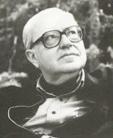![Piano's Solo Corner [Image]](piano8b.gif)
![Piano's Solo Corner [Image]](piano8b.gif)

| Date/Place of Birth: | 11 April, 1916 in Buenos Aires |
| Personality: | One of the most prominent Argentine composers in 20th Century. Besides that,
he also attained his prestige as one of the most sought-after music professors. His indefatigable didactic efforts in
nurturing young talented musicians & composers and promoting Argentine musical culture were indubitably shown by his hectic
participations as the following:
Consequently, Ginastera was so appreciated and revered that he received several prestigious honours from several universities like National Academy of Fine Arts of Argentina (1957); the Brazilian Academy of Music (1958); the American Academy of Arts and Sciences (1965) and the American Academy of Arts and Letters (1968). He was also awarded an honorary doctorate by Yale University in 1968 and the National Grand Prize for the Arts from the Argentine Ministry of Culture and Education in 1971. Meanwhile, he was universally recognized as a composer as his works were often performed in various festivals which resulted in rapturous success. |
| Piano-Playing Style: | Due to lack of resources about Ginastera's biography, I could not find any information about his playing style. I would be glad if you could recommend any decent book about his biography. |
| Music: | Ginastera classified his oeuvre into three periods:
|
| Composing Habit: | Ginastera was a perfectionist - he was extremely assiduous and scrupulous in his compositions. It was a habit that he destroyed many of them, especially those early works with which he
was not always satisfied. Hence, his total output was a small one.
In the first period of his oeuvre, Ginastera often applied the materials from the Argentine folk music as stated above, which was very similiar to Bartók's approach in his compositions. However, in the last period of his works, the composer used 12-tone method, polytonality, quarter tones and other micro-intervals as the model of his works. While the music is atonal, he often worked within the frame of traditional forms like Sonata form, Theme & Variations etc. Meanwhile, he also applied a quotation technique, one of the powerful composing tools in 20th Century music where a particular theme is borrowed from other composer's works, just like what Charles Ives invariably did in his compositions. In addition, Ginastera further extended the limits of instrumental and vocal techniques which resulted in enriched colors and moods. For example, use of clusters, microtonal sonorities and aleatory structures which demand for virtuosic playing and challenging but unusual vocal skills such as mimicking the dog's howling as in his Beatrix Cenci. (Note: Aleatory music represents music that is composed through chance procedures, also known as Chance Music) |
| Ginastera's Death: | 25 June, 1983 in Geneva. |